|
|

All rights reserved.
Ever since embarking on this career, and perhaps influenced by my earlier working life, I've had the nagging doubt that nature photography is really a pretty frivolous way to earn a living. I always feel a little uncomfortable referring to it as work, even although I am much more intellectually engaged than I ever was hoeing rows of strawberries. Yet much professional nature photography - and I include most of my own "work" in this - fails to serve much purpose beyond supporting the family when it could, with a new direction, give people something more substantial to chew on as well. There is a number of inter-related factors which have brought mainstream professional nature photography to its current state of inertia. As with any other business there is a drive to maximise the return on investment, in this case by concentrating on guaranteed, blue chip opportunities - Antarctica, Patagonia, The Falklands, Belize Zoo, Sannibel, Yellowstone, Churchill, the Mara, Amboseli, Hokkaido, Borneo and so on around the world. As more and more monied part-timers, especially in the US, sell their pictures through the major agencies, so a redistribution of sales has occurred, making it harder for the full-timers who have worked the international circuit for years to justify their costs in the face of diminishing returns. It's a simple case of supply and demand and if your photographic repertoire is no broader than species and locations for which there is a guaranteed demand, then you risk leaving yourself wide open to savvy, well financed competition.
So, it has come to this: more and more people taking more and more similar pictures of the same, celebrity species and locations - and employing whatever subterfuge is called for along the way. The professionals do it in response to buyers who are largely ignorant (though with notable exceptions) of the diversity of the natural world, or are at least preoccupied with established successful formulae. And amateurs, I believe mistakenly, too often simply follow the lead of the professionals.
Another altogether more draconian form of control has been proposed by the respected American environmentalist, Bill McKibben. Perhaps weary of the lack of headway being made against the real villains, he directed a considered attack on professional nature photography in the Fall 1997 edition of DoubleTake Magazine. In his article, "The Problem with Wildlife Photography" he proposed a moratorium on the professional production of any more wildlife photography with the current stock going into a single clearing house from which users would obtain whatever they needed. Central to McKibben's reasoning was the belief that there is a vast oversupply of most things that are in demand already and that continuing to invade the lives of our subjects is counterproductive. He also expressed grave doubts about the value of photography emerging from game farms, and the more general issue of the Edenic view of the world portrayed by most wildlife photographers, "How can there really be a shortage of whooping cranes when you've seen a thousand images of them - seen ten times more images than there are actually whooping cranes left in the wild?" These are valid and troubling points but in his central argument, Bill McKibben is mistaken. The real problem with wildlife photography is not that there is too much of it but that photographers - amateur and professional - are failing to reflect natural diversity. Far from inhibiting productivity, it needs to be expanded greatly, telling the story of species and locations unknown to readers and viewers. Implicit in every photograph is the judgement that the subject is worthy of attention. By only ever shooting pictures of the well known species and locations and established motifs, we hint that they are the only ones that merit care and attention, that the landscape is, in the words of one English photographer, "A few beauty spots with lots of boring bits in between." But as the philosopher Paul Sheppard asserts in his 1992 essay, A Post-Historic Primitivism, "The corporate world would destroy wildness in a trade for wilderness. Its intent is to restrict the play of free and selfish genes, to establish a dichotomy of places, to banish wild forms to places where they may be encountered by audiences while the business of domesticating the planet proceeds." It is, then, the underlying vitality of wild nature -wildness, rather than its purest expression - wilderness - which urgently requires our attention. And by turning our back on the celebrity locations and species - do we really need any more pictures of elephants? We can find a way out of the mire of homogeneity that bedevils so much contemporary nature photography. The loss of community with the natural world is a characteristic of industrialised societies, and nature photography which values the exotic over the domestic does nothing to re-establish these ties. But what form does engagement take - what practical use does nature photography have? Can it ever be something other than just another consumer activity done for our own satisfaction?
Like many countries with lots of wild land, Latvia, the central of the three Baltic republics, has a proportionately much lower membership of conservation organisations than, for example, England or the Netherlands. The threats from agricultural intensification expected after EU accession or from west European peat extraction companies looking for new areas to develop/exploit are low in the public consciousness. Yet they are real. The country's main conservation NGO, the LOB, through its director Maris Strazds, is active and effective at campaigning for habitat and species protection. However, as with many conservation groups in the former Soviet Bloc, money is tight for "extras" such as photography, something their west European colleagues know can be central to the success of campaigns. Nevertheless, the LOB recently published a series of bird guides illustrated with photos donated mainly by Latvian and Austrian photographers. It has proved to be very popular, increasing public knowledge of and interest in this biologically rich region. Photos of home, of familiar species, engage interest more powerfully than those of the exotic. My own, on-going commitment to Latvia includes organising the Photographers for Latvia initiative which next spring will bring a group of professional wildlife photographers and writers from western Europe together with Latvian colleagues for a week's intensive photography near the Russian border. The idea is provide pictures for the LOB to use in its campaigns as well as material for each of us to write about Latvia in our domestic newspapers and magazines, thereby increasing international knowledge of the green heart of the Baltics.
It is strange, perhaps, that at a time when abuse of the environment is rife and our knowledge of these abuses is greater than ever before, that so many of us - myself included - continue to peddle images which suggest that all is well in the wilderness. Not only are we failing to reflect natural diversity but too often we offer our viewers an unrepresentative, even misleading, view of the world. The reasons why we do this are obvious. Photographs of wilderness - areas with scant evidence of human influence - hint at the opportunity to act at will, without societal constraints. As the Canadian photographer Freeman Patterson has observed, the camera points both ways and in wilderness photos we can see reflected our dreams of freedom. The pictures, then, are not simply documents of the natural world, they are statements of personal aspirations. Well, like it or not, Arcadia ended with the start of the Industrial Age and continuing endlessly to restate the wilderness ideal in our photographs does little to move the debate forward. If we are satisfied simply to create a selective inventory of dwindling bio-diversity, then we can carry on as at present. I remain to be convinced that the corporate world is directly susceptible to powerful imagery of the natural world, skeptical that its constitutional opposition to wildness can ever be diminished by pictures of it. Public opinion, on the other hand is, and it is one thing that does make corporations - and politicians in the corporate thrall - sit up and take notice. The work of Carleton Watkins, William Henry Jackson and Ansel Adams, after all, was central to garnering the political will to set aside Yellowstone and Yosemite as national parks. In the late 20th century, the pictures of Latvian-born Peter Dombrovskis were instrumental in winning popular support for the protection of tracts of wild Tasmania. His large format images which, in the words of English photographer Joe Cornish, "Represent Nature unmediated by the photographic process", set an example for all campaigning photographers and compelling evidence of the value of working "under-exposed" areas.
It is hard to know how much influence large competitions like this have on prevailing styles although I'm sure, like me, you've heard fellow photographers say in the field, "Well, that's one for World in Our Hands", or "This is going to be for Composition and Form." What is clear is how stylistically conservative most entries to this and other competitions remain (I've given up entering, for I too am an involuntary conservative), reflecting, I believe, a greater inertia in our branch of the medium. Where are the black and white images, the selectively coloured ones and those made with tilting lenses? The huge style changes in fashion, portrait and even to some extent, product photography since the 1980šs, have left nature photography largely untouched. We are not faddish people, by and large, but we should recognise that an evolution of style is essential if we want people to continue looking at things wešve shown them many times before. Style, however, is nothing more than the means to an end, a way of engaging the viewer's interest. What should concern us more is the content of our pictures. We all want to have our voice heard, but how many of us actually have anything new to say? NB-NPN 018 Epilogue - Publisher's Note We go to the same places to photograph the same subjects, using the exact same lens, the exact same film and exactly the same approach to the subject. Like Saturday night reruns, our photography (and the story it tells) becomes nothing more than a cookie-cutter imitation of the style and subject matter that have made a few famous. Learning by imitation may be a necessary step in the process of becoming a competent nature photographer. But until we can take the next step and explore new (and lesser known) subject matter and locales, and develop our own unique style in the process, we will indeed never have anything new to say. Our sincere thanks to Niall Benvie for offering this article for publication on Nature Photographers Online Magazine. Niall's latest book, Creative Landscape Photography is now available at local book stores and in the NPN Gift Shoppe. Comments on this article? Send them to the editor. |
|
|
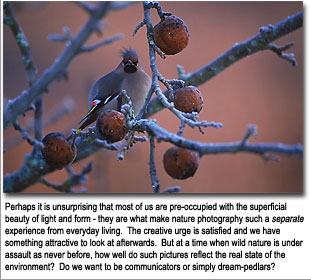 Long before I became a professional photographer and writer, I was a
farmer. Not an agricultural businessman, just a small farmer growing berries, grain
and some potatoes. And although that chapter of my life closed on a gloomy
February afternoon 12 years ago I still enjoy asking those in the
business why they farm. "Because we've farmed here for generations," or, "It's how
I support my family" are common responses when, in fact, I wonder if the
right answer should not be "To grow food for people to eat."
Long before I became a professional photographer and writer, I was a
farmer. Not an agricultural businessman, just a small farmer growing berries, grain
and some potatoes. And although that chapter of my life closed on a gloomy
February afternoon 12 years ago I still enjoy asking those in the
business why they farm. "Because we've farmed here for generations," or, "It's how
I support my family" are common responses when, in fact, I wonder if the
right answer should not be "To grow food for people to eat." There is a big trend too towards "fantasy photography" which involves
staging pictures with animals kept for no reason other than to provide
photographic opportunities. The game farm scene has grown in the United
States from just a few operators hiring out trained large carnivores for
movies to an industry using hundreds of captive animals from porcupines
to grizzlies, promising great images to individuals who may have no
knowledge of the animal's biology. The resulting pictures are therefore entirely
without context; the story they tell is fictitious. It is a shame that
some of the moral indignation normally reserved for digital enhancement isn't
directed at this business which really does have ethical problems. Game
farm advocates argue that these animals are the foot soldiers in the war for
conservation and that without the picture opportunities they provide the
cause would be weakened. I don't accept this argument; these animals are
the camp prostitutes of the business, providing easy rewards for those who pay
their money. And what message do such pictures send out to viewers; that
snarling pumas and grizzly bears are approachable? That normally
crepuscular or nocturnal species can be seen in broad daylight or that they have that
much fat? Worst of all, game farm pictures set up a false expectation of
what can be seen in the wild. In truth, this type of photography, and even
some of the pictures that I and others stage with falconer's birds, bear
little relation to our collective experience of wild nature. In pursuit of
the pound, we risk serving no ends other than our own and certainly add
little to the revelation of the natural world.
There is a big trend too towards "fantasy photography" which involves
staging pictures with animals kept for no reason other than to provide
photographic opportunities. The game farm scene has grown in the United
States from just a few operators hiring out trained large carnivores for
movies to an industry using hundreds of captive animals from porcupines
to grizzlies, promising great images to individuals who may have no
knowledge of the animal's biology. The resulting pictures are therefore entirely
without context; the story they tell is fictitious. It is a shame that
some of the moral indignation normally reserved for digital enhancement isn't
directed at this business which really does have ethical problems. Game
farm advocates argue that these animals are the foot soldiers in the war for
conservation and that without the picture opportunities they provide the
cause would be weakened. I don't accept this argument; these animals are
the camp prostitutes of the business, providing easy rewards for those who pay
their money. And what message do such pictures send out to viewers; that
snarling pumas and grizzly bears are approachable? That normally
crepuscular or nocturnal species can be seen in broad daylight or that they have that
much fat? Worst of all, game farm pictures set up a false expectation of
what can be seen in the wild. In truth, this type of photography, and even
some of the pictures that I and others stage with falconer's birds, bear
little relation to our collective experience of wild nature. In pursuit of
the pound, we risk serving no ends other than our own and certainly add
little to the revelation of the natural world.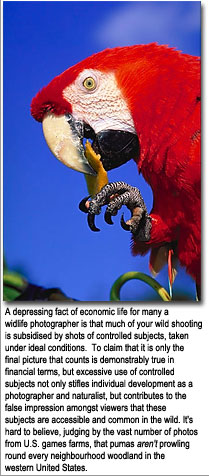 The end result of this process must inevitably be controls of the sort
that are inimical to the creative process. We see it already in the permit
system in some US National Parks and in other areas where access is restricted to
certain times of day. There are a number of well known sites in Britain
which, owing to the sheer number of photographers they now attract, may
have restrictions introduced which will curtail our freedom to create pictures.
The photographers who complain about such restrictions must, however, be
able to justify their presence in these places. What does their work add
to that which has already been done before at that site? How will they answer
the question of the regulators, "Why don't you go and shoot somewhere
else and give these [capercaillie/sea eagles/grey seals, etc.] a break?"
The end result of this process must inevitably be controls of the sort
that are inimical to the creative process. We see it already in the permit
system in some US National Parks and in other areas where access is restricted to
certain times of day. There are a number of well known sites in Britain
which, owing to the sheer number of photographers they now attract, may
have restrictions introduced which will curtail our freedom to create pictures.
The photographers who complain about such restrictions must, however, be
able to justify their presence in these places. What does their work add
to that which has already been done before at that site? How will they answer
the question of the regulators, "Why don't you go and shoot somewhere
else and give these [capercaillie/sea eagles/grey seals, etc.] a break?"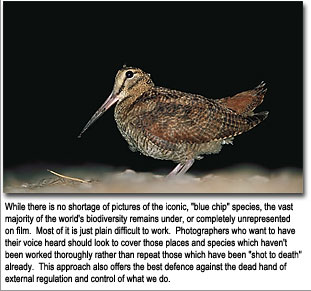 As the world has become more familiar, there has been a trend for nature
photography to become more about photography than nature. We are always
looking for a different way to tell the same old story. Yet there are
plenty of new stories out there to be told, in simple language, for the first
time. Moreover, there are places that need and deserve the attention that
photography brings to them - and where photography can have some practical
use.
As the world has become more familiar, there has been a trend for nature
photography to become more about photography than nature. We are always
looking for a different way to tell the same old story. Yet there are
plenty of new stories out there to be told, in simple language, for the first
time. Moreover, there are places that need and deserve the attention that
photography brings to them - and where photography can have some practical
use.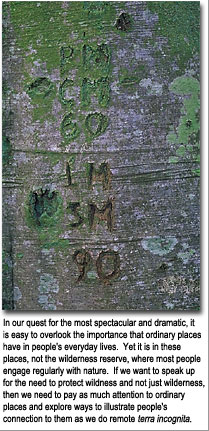 Even within Europe, there are other Latvias needing our attention. And if
we look further afield, consider how much coverage of the tropical
rainforests remains to be done. This is work not just for professionals - some of
whom will want to continue trying to make the game farm/honey-pot-travel
approach pay - but for those amateur photographers who see the natural world as
something other than a series of photo opportunities. It is an approach
that should appeal to everyone who resents controls on creativity and is
concerned about what is happening to the natural world.
Even within Europe, there are other Latvias needing our attention. And if
we look further afield, consider how much coverage of the tropical
rainforests remains to be done. This is work not just for professionals - some of
whom will want to continue trying to make the game farm/honey-pot-travel
approach pay - but for those amateur photographers who see the natural world as
something other than a series of photo opportunities. It is an approach
that should appeal to everyone who resents controls on creativity and is
concerned about what is happening to the natural world.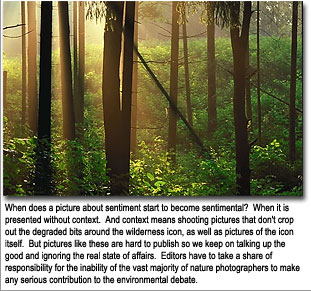 If we want to be regarded as serious contributors to the debate on what
happens to wildness, then we need to consider the content, not just the
appearance of our images, more critically then we tend to at the moment.
If that sounds like a sweeping generalisation, you may be right.
Nevertheless, I can make it from the privileged position as a judge in the 2001 British
Gas Wildlife Photographer of the Year Competition, widely regarded as a
showcase for the best contemporary nature photography from around the
world. As we looked through the final selections, I hunted with increasing
desperation for that fresh vision of the natural world, of someone with
something new to say, in terms of either style or content. I did find
some of those pictures, but in my opinion (I cannot speak for my fellow
judges), many fewer than such a prestigious competition should reveal.
If we want to be regarded as serious contributors to the debate on what
happens to wildness, then we need to consider the content, not just the
appearance of our images, more critically then we tend to at the moment.
If that sounds like a sweeping generalisation, you may be right.
Nevertheless, I can make it from the privileged position as a judge in the 2001 British
Gas Wildlife Photographer of the Year Competition, widely regarded as a
showcase for the best contemporary nature photography from around the
world. As we looked through the final selections, I hunted with increasing
desperation for that fresh vision of the natural world, of someone with
something new to say, in terms of either style or content. I did find
some of those pictures, but in my opinion (I cannot speak for my fellow
judges), many fewer than such a prestigious competition should reveal.